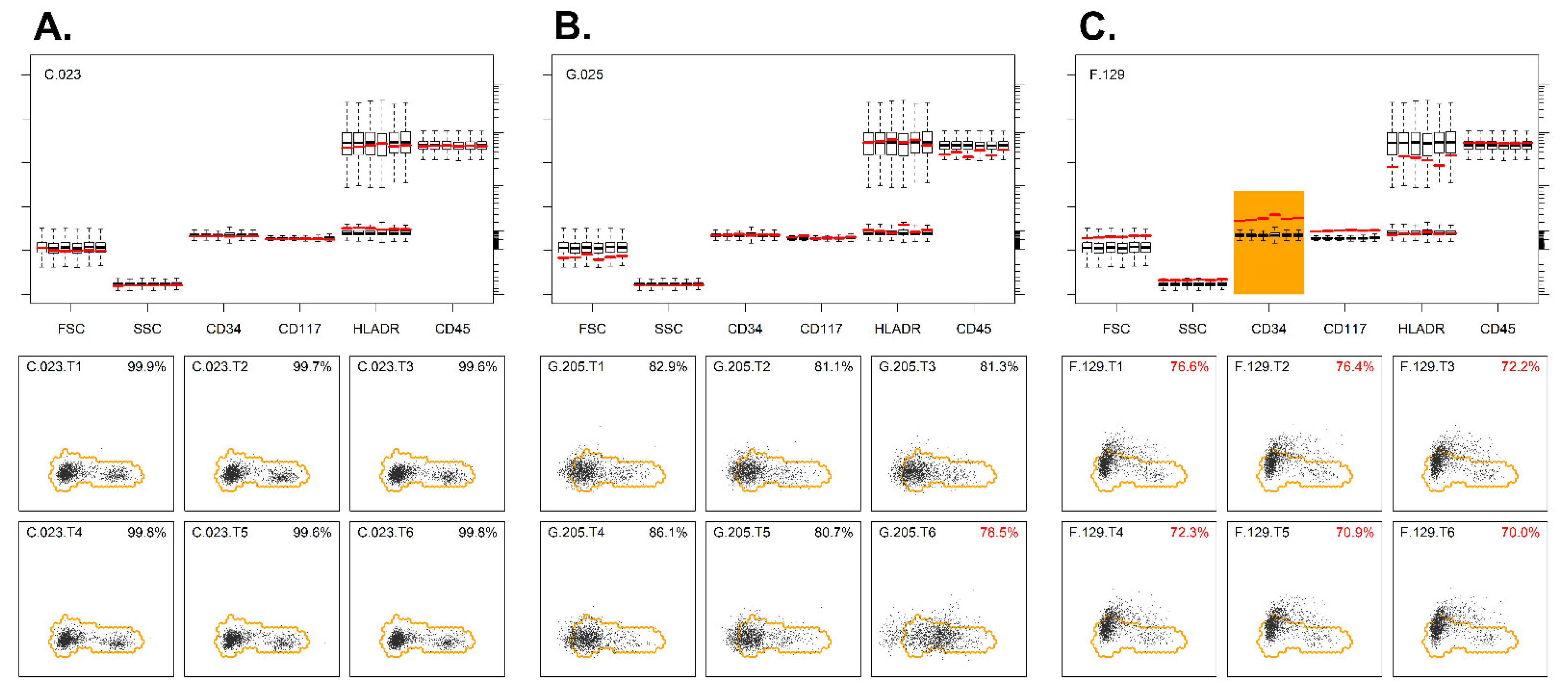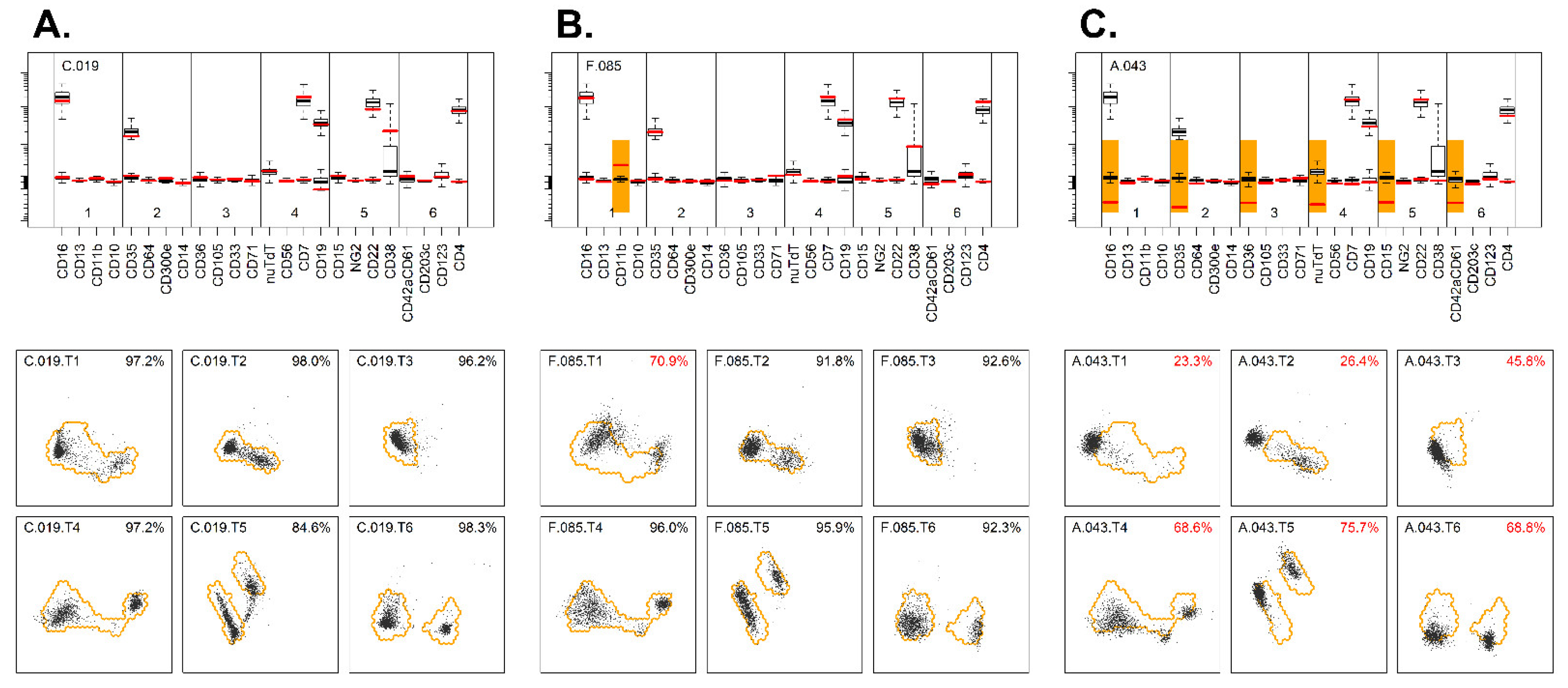Quality Assessment of a Large Multi-Center Flow Cytometric Dataset of Acute Myeloid Leukemia Patients—A EuroFlow Study
Abstract
:Simple Summary
Abstract
1. Introduction
2. Materials and Methods
2.1. Patients and Data
2.2. Normal Bone Marrow Samples
2.3. Data Collection and Evaluation
3. Results and Discussion
3.1. Data Collection
3.2. QA Stage 1: Initial Checks
3.3. QA Stage 2: Sanitization of FCS Files
3.4. QA Stage 3: Evaluation Based on Backbone Markers
3.5. QA Stage 4: Evaluation Based on Tube-Specific (TS) Markers
3.6. Detailed Analysis of Flagged Cases
3.7. Fixing of Sub-Optimal or Incomplete Cases
3.8. Final Cohort
3.9. QA Process Validation
3.10. Annotations
3.11. Data Analysis of AML Cohort: Immunophenotypic Profiles
3.12. Inclusion of Normal Bone Marrow Samples
3.13. Strictness of the QA
3.14. Applicability of the QA Procedure
4. Conclusions
Supplementary Materials
Author Contributions
Funding
Institutional Review Board Statement
Informed Consent Statement
Data Availability Statement
Acknowledgments
Conflicts of Interest
References
- Pedreira, C.E.; da Costa, E.S.; Lecrevise, Q.; Grigore, G.; Fluxa, R.; Verde, J.; Hernandez, J.; van Dongen, J.J.M.; Orfao, A. EuroFlow. From big flow cytometry datasets to smart diagnostic strategies: The EuroFlow approach. J. Immunol. Methods 2019, 475, 112631. [Google Scholar] [CrossRef] [PubMed]
- Van Dongen, J.J.; Lhermitte, L.; Bottcher, S.; Almeida, J.; van der Velden, V.H.; Flores-Montero, J.; Rawstron, A.; Asnafi, V.; Lecrevisse, Q.; Lucio, P.; et al. EuroFlow antibody panels for standardized n-dimensional flow cytometric immunophenotyping of normal, reactive and malignant leukocytes. Leukemia 2012, 26, 1908–1975. [Google Scholar] [CrossRef] [PubMed] [Green Version]
- Duetz, C.; Van Gassen, S.; Westers, T.M.; van Spronsen, M.F.; Bachas, C.; Saeys, Y.; van de Loosdrecht, A.A. Computational flow cytometry as a diagnostic tool in suspected-myelodysplastic syndromes. Cytom. Part A 2021, 99, 814–824. [Google Scholar] [CrossRef] [PubMed]
- Quintelier, K.; Couckuyt, A.; Emmaneel, A.; Aerts, J.; Saeys, Y.; Van Gassen, S. Analyzing high-dimensional cytometry data using FlowSOM. Nat. Protoc. 2021, 16, 3775–3801. [Google Scholar] [CrossRef] [PubMed]
- Van Gassen, S.; Callebaut, B.; Van Helden, M.J.; Lambrecht, B.N.; Demeester, P.; Dhaene, T.; Saeys, Y. FlowSOM: Using self-organizing maps for visualization and interpretation of cytometry data. Cytom. A 2015, 87, 636–645. [Google Scholar] [CrossRef] [PubMed]
- Flores-Montero, J.; Grigore, G.; Fluxá, R.; Hernández, J.; Fernandez, P.; Almeida, J.; Muñoz, N.; Böttcher, S.; Sedek, L.; van der Velden, V.; et al. EuroFlow Lymphoid Screening Tube (LST) data base for automated identification of blood lymphocyte subsets. J. Immunol. Methods 2019, 475, 112662. [Google Scholar] [CrossRef] [PubMed]
- Flores-Montero, J.; Sanoja-Flores, L.; Paiva, B.; Puig, N.; Garcia-Sanchez, O.; Bottcher, S.; van der Velden, V.H.; Perez-Moran, J.J.; Vidriales, M.B.; Garcia-Sanz, R.; et al. Next Generation Flow for highly sensitive and standardized detection of minimal re-sidual disease in multiple myeloma. Leukemia 2017, 31, 2094–2103. [Google Scholar] [CrossRef] [PubMed] [Green Version]
- Lhermitte, L.; Barreau, S.; Morf, D.; Fernandez, P.; Grigore, G.; Barrena, S.; de Bie, M.; Flores-Montero, J.; Brüggemann, M.; Mejstrikova, E.; et al. Automated identification of leukocyte subsets improves standardization of database-guided expert-supervised diagnostic orientation in acute leukemia: A EuroFlow study. Mod. Pathol. 2021, 34, 59–69. [Google Scholar] [CrossRef] [PubMed]
- Lhermitte, L.; Mejstrikova, E.; van der Sluijs-Gelling, A.J.; Grigore, G.E.; Sedek, L.; Bras, A.E.; Gaipa, G.; da Costa, E.S.; Novakova, M.; Sonneveld, E.; et al. Automated database-guided expert-supervised orientation for immunophenotypic diagnosis and classification of acute leukemia. Leukemia 2018, 32, 874–881. [Google Scholar] [CrossRef] [PubMed] [Green Version]
- Johansson, U.; Bloxham, D.; Couzens, S.; Jesson, J.; Morilla, R.; Erber, W.; Macey, M. British Committee for Standards in Haematology Guidelines on the use of multicolour flow cytometry in the diagnosis of haematological neoplasms. Br. J. Haematol. 2014, 165, 455–488. [Google Scholar] [CrossRef] [PubMed]
- Greig, B. Quality Control of Immunophenotyping; Humana: New York, NY, USA, 2019; Volume 2032, pp. 227–279. [Google Scholar]
- Wood, B.L.; Arroz, M.; Barnett, D.; DiGiuseppe, J.; Greig, B.; Kussick, S.J.; Oldaker, T.; Shenkin, M.; Stone, E.; Wallace, P. 2006 Bethesda International Consensus recommendations on the immunophenotypic analysis of hematolymphoid neoplasia by flow cytometry: Optimal reagents and reporting for the flow cytometric diagnosis of hematopoietic neoplasia. Cytom. Part B Clin. Cytom. 2007, 72, S14–S22. [Google Scholar] [CrossRef] [PubMed]
- Kalina, T.; Flores-Montero, J.; Lecrevisse, Q.; Pedreira, C.E.; Van Der Velden, V.H.J.; Novakova, M.; Mejstrikova, E.; Hrusak, O.; Böttcher, S.; Karsch, D.; et al. Quality assessment program for EuroFlow protocols: Summary results of four-year (2010–2013) quality assurance rounds. Cytom. A 2015, 87, 145–156. [Google Scholar] [CrossRef] [PubMed]
- Kalina, T.; Flores-Montero, J.; van der Velden, V.H.J.; Martin-Ayuso, M.; Böttcher, S.; Ritgen, M.; Almeida, J.; Lhermitte, L.; Asnafi, V.; Mendonça, A.; et al. EuroFlow standardization of flow cytometer instrument settings and immunophenotyping protocols. Leukemia 2012, 26, 1986–2010. [Google Scholar] [CrossRef] [PubMed] [Green Version]
- Theunissen, P.M.J.; Branden, A.V.D.; Van Der Sluijs-Gelling, A.; De Haas, V.; Beishuizen, A.; Van Dongen, J.; Van Der Velden, V.H.J. Understanding the reconstitution of the B-cell compartment in bone marrow and blood after treatment for B-cell precursor acute lymphoblastic leukaemia. Br. J. Haematol. 2017, 178, 267–278. [Google Scholar] [CrossRef] [PubMed]
- Hrušák, O.; Porwit-MacDonald, A. Antigen expression patterns reflecting genotype of acute leukemias. Leukemia 2002, 16, 1233–1258. [Google Scholar] [CrossRef] [PubMed]
- Monaco, G.; Chen, H.; Poidinger, M.; Chen, J.; de Magalhaes, J.P.; Larbi, A. flowAI: Automatic and interactive anomaly discern-ing tools for flow cytometry data. Bioinformatics 2016, 32, 2473–2480. [Google Scholar] [CrossRef] [PubMed] [Green Version]
- Hahne, F.; LeMeur, N.; Brinkman, R.R.; Ellis, B.; Haaland, P.; Sarkar, D.; Spidlen, J.; Strain, E.; Gentleman, R. flowCore: A Biocon-ductor package for high throughput flow cytometry. BMC Bioinform. 2009, 10, 106. [Google Scholar] [CrossRef] [PubMed] [Green Version]




| Parameter | Final Cohort (n = 401) |
|---|---|
| Gender (M/F) | 217/184 |
| Age (years; median [range]) | 53 [0–93] |
| WBC (x109/L; median [range]) | 15 [0–441] |
| WHO classification | |
| |
| •t(8;21) | 16 |
| •Inv(16)/t(16;16) | 21 |
| •t(15;17) | 23 |
| •t(9;11) | 9 |
| •t(6;9) | 2 |
| •inv(3)/t(3;3) | 2 |
| •NPM1 | 109 a |
| •Biallelic CEBPA | 13 a |
| •RUNX1 | 4 |
| 41 |
| 21 |
| 137 |
| •Minimal differentiation | 14 |
| •Without maturation | 25 |
| •With maturation | 32 |
| •Myelomonocytic | 22 |
| •Monoblastic/monocytic | 30 |
| •Pure erythroid | 7 |
| •Megakaryoblastic | 7 |
| 5 |
| •TAM/DS-ML | 5 |
Publisher’s Note: MDPI stays neutral with regard to jurisdictional claims in published maps and institutional affiliations. |
© 2022 by the authors. Licensee MDPI, Basel, Switzerland. This article is an open access article distributed under the terms and conditions of the Creative Commons Attribution (CC BY) license (https://creativecommons.org/licenses/by/4.0/).
Share and Cite
Bras, A.E.; Matarraz, S.; Nierkens, S.; Fernández, P.; Philippé, J.; Aanei, C.-M.; de Mello, F.V.; Burgos, L.; van der Sluijs-Gelling, A.J.; Grigore, G.E.; et al. Quality Assessment of a Large Multi-Center Flow Cytometric Dataset of Acute Myeloid Leukemia Patients—A EuroFlow Study. Cancers 2022, 14, 2011. https://doi.org/10.3390/cancers14082011
Bras AE, Matarraz S, Nierkens S, Fernández P, Philippé J, Aanei C-M, de Mello FV, Burgos L, van der Sluijs-Gelling AJ, Grigore GE, et al. Quality Assessment of a Large Multi-Center Flow Cytometric Dataset of Acute Myeloid Leukemia Patients—A EuroFlow Study. Cancers. 2022; 14(8):2011. https://doi.org/10.3390/cancers14082011
Chicago/Turabian StyleBras, Anne E., Sergio Matarraz, Stefan Nierkens, Paula Fernández, Jan Philippé, Carmen-Mariana Aanei, Fabiana Vieira de Mello, Leire Burgos, Alita J. van der Sluijs-Gelling, Georgiana Emilia Grigore, and et al. 2022. "Quality Assessment of a Large Multi-Center Flow Cytometric Dataset of Acute Myeloid Leukemia Patients—A EuroFlow Study" Cancers 14, no. 8: 2011. https://doi.org/10.3390/cancers14082011
APA StyleBras, A. E., Matarraz, S., Nierkens, S., Fernández, P., Philippé, J., Aanei, C.-M., de Mello, F. V., Burgos, L., van der Sluijs-Gelling, A. J., Grigore, G. E., van Dongen, J. J. M., Orfao, A., van der Velden, V. H. J., & on behalf of the EuroFlow Consortium. (2022). Quality Assessment of a Large Multi-Center Flow Cytometric Dataset of Acute Myeloid Leukemia Patients—A EuroFlow Study. Cancers, 14(8), 2011. https://doi.org/10.3390/cancers14082011






